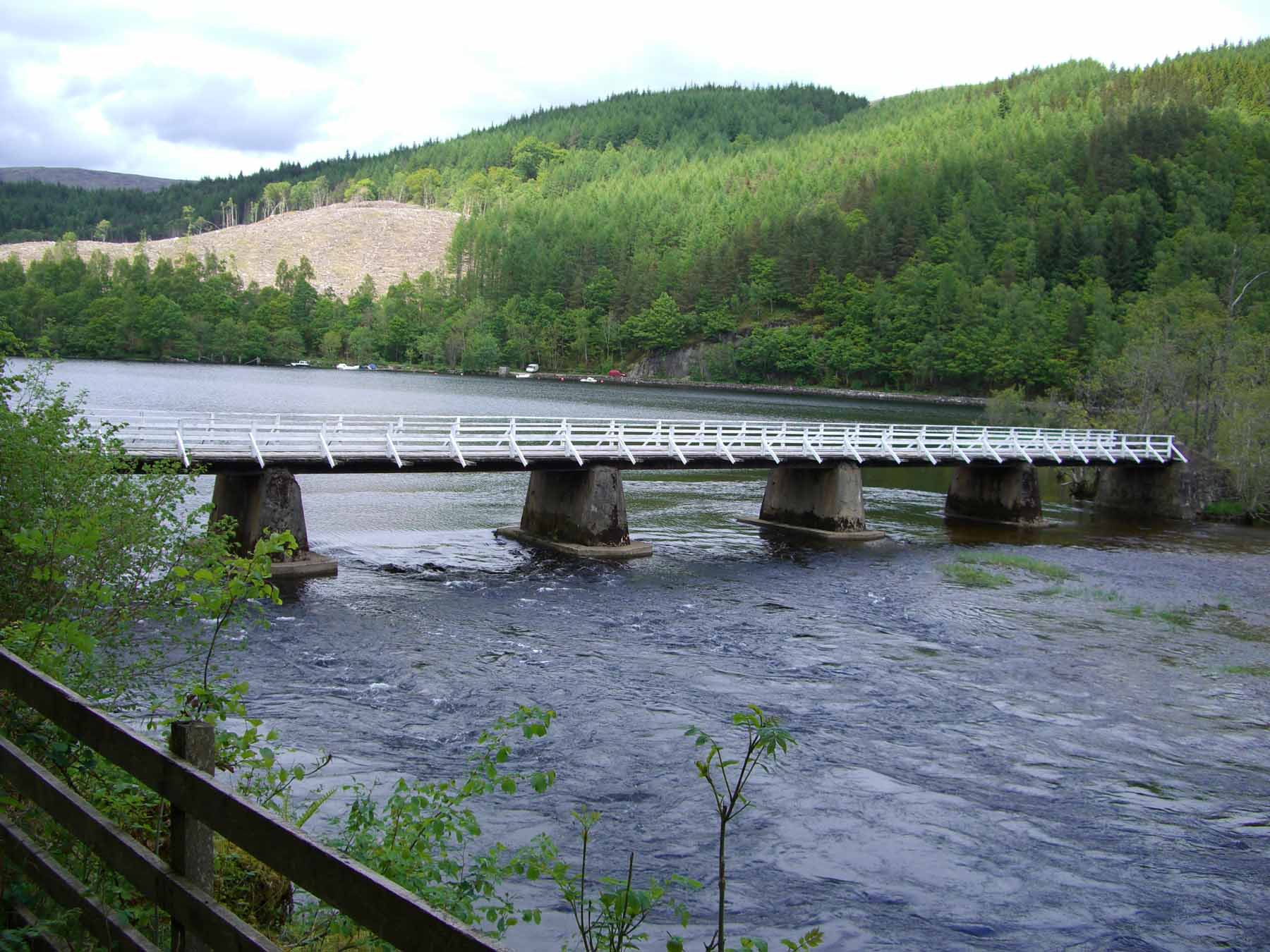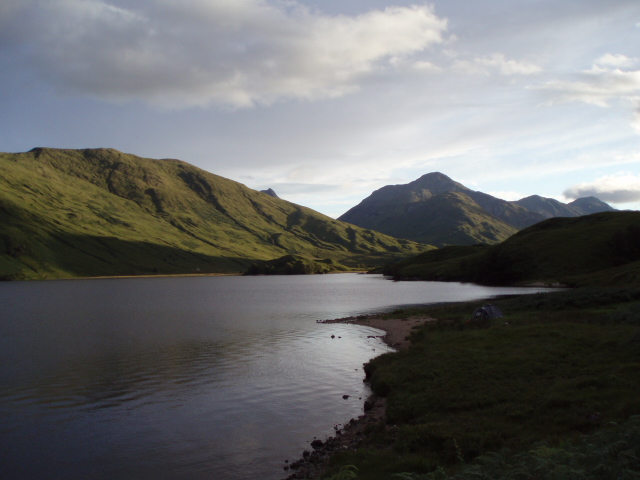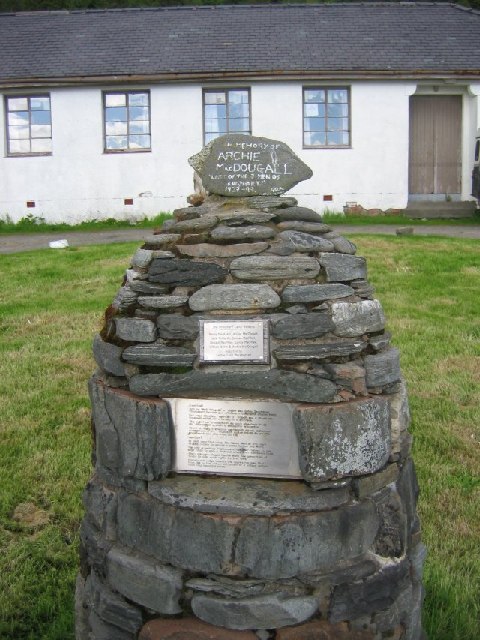|
River Arkaig
Loch Arkaig (Scottish Gaelic: Loch Airceig) is a body of freshwater in Lochaber, Scotland, to the west of the Great Glen. It is approximately in length and lies above sea level, the maximum depth is around The main tributaries are the Dessarry and the Pean which flow through the glens of the same names, falling into the loch at the extreme west end, by the settlement of Strathan. The mountains of Lochaber lie to the north, and the Forest of Locheil to the south. The outflow is through the River Arkaig at the extreme southeast of the loch, which flows eastwards to Loch Lochy, passing Achnacarry. Two small islands lie at the eastern end of the loch, the larger of which, Island Columbkill, or Eilean Loch Airceig, is the site of a ruined chapel dedicated to St Columba which is the former burial ground of the Camerons of Locheil. A road from the Great Glen follows the north shore of the loch to Strathan where paths lead on to Knoydart, Glenfinnan and Loch Morar. In 1746, Jacobit ... [...More Info...] [...Related Items...] OR: [Wikipedia] [Google] [Baidu] |
Lochaber
Lochaber ( ; gd, Loch Abar) is a name applied to a part of the Scottish Highlands. Historically, it was a provincial lordship consisting of the parishes of Kilmallie and Kilmonivaig, as they were before being reduced in extent by the creation of ''Quoad Sacra'' parishes in the 19th century. Lochaber once extended from the Northern shore of Loch Leven, a district called Nether Lochaber, to beyond Spean Bridge and Roybridge, which area is known as Brae Lochaber or ''Braigh Loch Abar'' in Gaelic. Lochaber is now also used to refer to a much wider area, one of the 16 ward management areas of the Highland Council of Scotland and one of eight former local government districts of the two-tier Highland region. The main town of Lochaber is Fort William. According to legend, a glaistig, a ghostly woman-goat hybrid, once lived in the area. Name William Watson outlined two schools of thought on this topic. He favoured the idea that ''Abar'' came from the Pictish and Welsh for "river m ... [...More Info...] [...Related Items...] OR: [Wikipedia] [Google] [Baidu] |
Glenfinnan
Glenfinnan ( gd, Gleann Fhionnain ) is a hamlet in Lochaber area of the Highlands of Scotland. In 1745 the Jacobite rising began here when Prince Charles Edward Stuart ("Bonnie Prince Charlie") raised his standard on the shores of Loch Shiel. Seventy years later, the 18 m (60 ft) Glenfinnan Monument, at the head of the loch, was erected to commemorate the historic event. Jacobite rising Prince Charles landed from France on Eriskay in the Western Isles, travelling to the mainland in a small rowing boat, coming ashore at Loch nan Uamh just west of Glenfinnan. On arrival on the Scottish mainland, he was met by a small number of MacDonalds. Stuart waited at Glenfinnan as more MacDonalds, Camerons, Macfies, and MacDonnells arrived. On 19 August 1745, after Prince Charles judged he had enough military support, he climbed the hill near Glenfinnan as MacMaster of Glenaladale raised his royal standard. The Young Pretender announced to all the mustered clans he claimed t ... [...More Info...] [...Related Items...] OR: [Wikipedia] [Google] [Baidu] |
Lochs Of Highland (council Area)
''Loch'' () is the Scottish Gaelic, Scots and Irish word for a lake or sea inlet. It is cognate with the Manx lough, Cornish logh, and one of the Welsh words for lake, llwch. In English English and Hiberno-English, the anglicised spelling lough is commonly found in place names; in Lowland Scots and Scottish English, the spelling "loch" is always used. Many loughs are connected to stories of lake-bursts, signifying their mythical origin. Sea-inlet lochs are often called sea lochs or sea loughs. Some such bodies of water could also be called firths, fjords, estuaries, straits or bays. Background This name for a body of water is Insular CelticThe current form has currency in the following languages: Scottish Gaelic, Irish, Manx, and has been borrowed into Lowland Scots, Scottish English, Irish English and Standard English. in origin and is applied to most lakes in Scotland and to many sea inlets in the west and north of Scotland. The word comes from Proto-Indo-Europea ... [...More Info...] [...Related Items...] OR: [Wikipedia] [Google] [Baidu] |
Francis Egerton, 1st Earl Of Ellesmere
Francis Egerton, 1st Earl of Ellesmere, (1 January 1800 – 18 February 1857), known as Lord Francis Leveson-Gower until 1833, was a British politician, writer, traveller and patron of the arts. Ellesmere Island, a major island (10th in size among global islands) in Nunavut, the Canadian Arctic, was named after him. Background and education Ellesmere was born at 21 Arlington Street, Piccadilly, London, on 1 January 1800, the third son of George Leveson-Gower (then known as Lord Gower) and his wife, Elizabeth Gordon who was 19th Countess of Sutherland in her own right. He was educated at Eton and Christ Church, Oxford, and then held a commission in the Life Guards, which he resigned on his marriage. In October 1803 his father became Marquess of Stafford, having shortly before inherited the considerable wealth (but not the titles) of Francis Egerton, 3rd Duke of Bridgewater, whose will provided that the Bridgewater estates should next pass to Francis, rather than his elder brot ... [...More Info...] [...Related Items...] OR: [Wikipedia] [Google] [Baidu] |
Loch Assynt
Loch Assynt ( gd, Loch Asaint) is a freshwater loch in Sutherland, Scotland, east-north east of Lochinver. Situated in a spectacular setting between the heights of Canisp, Quinag and Beinn Uidhe, it receives the outflow from Lochs Awe, Maol a' Choire, and Leitir Easaich. It discharges into the sea at Loch Inver, via the river Inver. The general trend of the loch is west-northwest and east-southeast, while the western end bends sharply at Loch Assynt lodge to the southwest.Murray and Pullar (1910"Lochs of the Inver Basin"Page 149, Volume II, Part I. National Library of Scotland. Retrieved 16 July 2021 The loch is long, and about in maximum breadth. The total area is approximately and its drainage basin is over . The total volume of the loch is approximately and the maximum depth is . There is excellent fishing for trout, sea-trout, and salmon. Ardvreck Castle, once held by the MacLeods and Mackenzies, occupies a promontory on the north shore, west of Inchnadamph. The e ... [...More Info...] [...Related Items...] OR: [Wikipedia] [Google] [Baidu] |
Queen Victoria
Victoria (Alexandrina Victoria; 24 May 1819 – 22 January 1901) was Queen of the United Kingdom of Great Britain and Ireland from 20 June 1837 until Death and state funeral of Queen Victoria, her death in 1901. Her reign of 63 years and 216 days was longer than that of List of monarchs in Britain by length of reign, any previous British monarch and is known as the Victorian era. It was a period of industrial, political, scientific, and military change within the United Kingdom, and was marked by a great expansion of the British Empire. In 1876, the British Parliament voted to grant her the additional title of Empress of India. Victoria was the daughter of Prince Edward, Duke of Kent and Strathearn (the fourth son of King George III), and Princess Victoria of Saxe-Coburg-Saalfeld. After the deaths of her father and grandfather in 1820, she was Kensington System, raised under close supervision by her mother and her comptroller, John Conroy. She inherited the throne aged 18 af ... [...More Info...] [...Related Items...] OR: [Wikipedia] [Google] [Baidu] |
James Howard Harris, 3rd Earl Of Malmesbury
James Howard Harris, 3rd Earl of Malmesbury, GCB, PC (25 March 1807 – 17 May 1889), styled Viscount FitzHarris from 1820 to 1841, was a British statesman of the Victorian era. Background and education James Howard Harris was born on 25 March 1807 in London, the eldest son and heir of James Harris, 2nd Earl of Malmesbury, and his wife, Harriet Susan Dashwood, daughter of Francis Bateman Dashwood, of Well Vale, Lincolnshire, and his wife, Teresa March, daughter of John March, of Willeslet Park, Cambridgeshire.G.E. Cokayne, ''Complete Peerage'', 1st ed., vol. 5, p. 203 Having been educated privately, he went to Eton College, a Public school, and Oriel College, Oxford, graduating from the latter in 1828 with a Bachelor of Arts degree.D. Steele, "Harris, James Howard, third earl of Malmesbury (1807–1889)", ''Oxford Dictionary of National Biography'', 2004 In the years that followed his graduation, he went travelling around Europe and making acquaintance with aristocratic circle ... [...More Info...] [...Related Items...] OR: [Wikipedia] [Google] [Baidu] |
Water Horse
A water horse (or "waterhorse" in some folklore) is a mythical creature, such as the , , the and kelpie. Name origin The term "water horse" was originally a name given to the kelpie, a creature similar to the hippocamp, which has the head, neck and mane of a normal horse, front legs like a horse, webbed feet, and a long, two-lobed, whale-like tail. The term has also been used as a nickname for lake monsters, particularly Ogopogo and Nessie. The name "kelpie" has often been a nickname for many other Scottish lake monsters, such as each uisge and Morag of Loch Morar and Lizzie of Loch Lochy. Other names for these sea monsters include "seahorse" (not referring to the seahorse fish) and "hippocampus" (which is the genus name for seahorses). The usage of "water horse" or "kelpie" can often be a source of confusion; some consider the two terms to be synonymous, while others distinguish the water horse as a denizen of lochs and the kelpie of turbulent water such as rivers, fords, ... [...More Info...] [...Related Items...] OR: [Wikipedia] [Google] [Baidu] |
Loch Arkaig Treasure
The treasure of Loch Arkaig, sometimes known as the Jacobite gold, was a large amount of specie provided by Spain to finance the Jacobite rising in Scotland in 1745, and rumoured still to be hidden at Loch Arkaig in Lochaber. Background In 1745, Prince Charles Edward Stuart (Bonnie Prince Charlie) arrived in Scotland from France and claimed the thrones of Scotland, England and Ireland, in the name of his father James Stuart (the Old Pretender). Although Charles asserted that his venture was supported by Louis XV of France, and that the arrival of French forces in Scotland was imminent, in truth France had little intention to intervene on the Stuarts' behalf. However, some limited financial support was supplied by both Spain and the Pope. Spain pledged some 400,000 livres (or Louis d'Or) per month for the Jacobite cause. However, getting this money to the rebel army was the difficulty. The first instalment (sent via Charles' brother Henry who was resident in France) was dis ... [...More Info...] [...Related Items...] OR: [Wikipedia] [Google] [Baidu] |
Outflow Of Loch Arkaig , in atmospheric science, separating thunderstorm-cooled air from the surrounding air
{{disambig ...
Outflow may refer to: *Capital outflow, the capital leaving a particular economy *Bipolar outflow, in astronomy, two continuous flows of gas from the poles of a star *Outflow (hydrology), the discharge of a lake or other reservoir system *Outflow (meteorology), air that flows outwards from a thunderstorm *Outflow boundary An outflow boundary, also known as a gust front, is a storm-scale or mesoscale boundary separating thunderstorm-cooled air (outflow) from the surrounding air; similar in effect to a cold front, with passage marked by a wind shift and usually a ... [...More Info...] [...Related Items...] OR: [Wikipedia] [Google] [Baidu] |
Loch Morar
Loch Morar (Scottish Gaelic: Loch Mòrair) is a freshwater loch in Lochaber, Highland, Scotland. It is the fifth-largest loch by surface area in Scotland, at , and the deepest freshwater body in the British Isles with a maximum depth of . The loch was created by glacial action around 10,000 years ago, and has a surface elevation of above sea level. It separates the traditional district of North Morar (which contains the village of Morar), from Arisaig and Moidart. Geography Loch Morar is long, has a surface area of , and is the deepest freshwater body in the British Isles with a maximum depth of . In 1910, John Murray and Laurence Pullar found it to have a mean depth of and a total volume of during their survey of Scottish lochs. The bottom is deepened below the United Kingdom Continental Shelf, and until 1943, when a depth of was observed in the Inner Sound, it was believed to be the deepest water in the United Kingdom. The surface of the loch is above sea level. The ... [...More Info...] [...Related Items...] OR: [Wikipedia] [Google] [Baidu] |
Knoydart
Knoydart (Scottish Gaelic: ''Cnòideart'') is a peninsula in Lochaber, Highland, on the west coast of Scotland. Knoydart is sandwiched between Lochs Nevis and Hourn — often translated as "Loch Heaven" (from the Gaelic ''Loch Néimh'') and "Loch Hell" (Gaelic: ''Loch Iutharn'') respectively, although the somewhat poetic nature of these derivations is disputed. Forming the northern part of what is traditionally known as ''na Garbh-Chrìochan'' or "the Rough Bounds", because of its harsh terrain and remoteness, Knoydart is also referred to as "Britain's last wilderness". It is only accessible by boat, or by a 16-mile (26 km) walk through rough country, and the seven miles (11 km) of tarred road are not connected to the UK road system. Knoydart is designated as one of the forty national scenic areas in Scotland, which are defined so as to identify areas of exceptional scenery and to ensure their protection from inappropriate development. The designated area covers ... [...More Info...] [...Related Items...] OR: [Wikipedia] [Google] [Baidu] |








